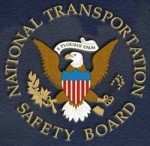Tue, Nov 17, 2009
Wants Stricter Guidelines For Government Helo Operators,
Legislation From FAA
 The NTSB Monday issued a set of
recommendations for the FAA and Public Helicopter Emergency Medical
Services Operators, following a 2008 fatal accident in Prince
Georges County, Maryland in which three people were killed and
another sustained serious injuries. The helicopter was being
operated by the Maryland State Police in a medevac operation.
The NTSB Monday issued a set of
recommendations for the FAA and Public Helicopter Emergency Medical
Services Operators, following a 2008 fatal accident in Prince
Georges County, Maryland in which three people were killed and
another sustained serious injuries. The helicopter was being
operated by the Maryland State Police in a medevac operation.
The NTSB determined that the probable cause of this accident was
the pilot's attempt to regain visual conditions by performing a
rapid descent and his failure to arrest the descent at the MDA
during a nonprecision approach. Contributing to the accident were
(1) the pilot’s limited recent instrument flight experience,
(2) the lack of adherence to effective risk management procedures
by the MSP, (3) the pilot’s inadequate assessment of the
weather, which led to his decision to accept the flight, (4) the
failure of the Potomac Consolidated Terminal Radar Approach Control
(PCT) controller to provide the current ADW weather observation to
the pilot, and (5) the increased workload on the pilot due to
inadequate FAA air traffic control handling by the DCA Tower and
PCT controllers.
In light of the accident, the NTSB has recommended that
operators of medical helicopters, and in particular governments
engaging in medevac operations:
- Develop and implement flight risk evaluation programs that
include training for all employees involved in the operation,
procedures that support the systematic evaluation of flight risks,
and consultation with others trained in helicopter emergency
medical services flight operations if the risks reach a predefined
level.
- Use formalized dispatch and flight-following procedures that
include up-to-date weather information and assistance in flight
risk assessment decisions.
- Install terrain awareness and warning systems on your aircraft
and provide adequate training to ensure that flight crews are
capable of using the systems to safely conduct helicopter emergency
medical services operations.
 In a companion letter to the FAA,
NTSB Chair Deborah Hersman recommends that Administrator Babbitt
seek specific legislative authority to regulate helicopter
emergency medical services (HEMS) operations conducted using
government-owned aircraft to achieve safety oversight commensurate
with that provided to civil HEMS operations.
In a companion letter to the FAA,
NTSB Chair Deborah Hersman recommends that Administrator Babbitt
seek specific legislative authority to regulate helicopter
emergency medical services (HEMS) operations conducted using
government-owned aircraft to achieve safety oversight commensurate
with that provided to civil HEMS operations.
In addition, the NTSB reiterated the following previously issued
recommendations to the Federal Aviation Administration:
- Require all emergency medical services (EMS) operators to
develop and implement flight risk evaluation programs that include
training all employees involved in the operation, procedures that
support the systematic evaluation of flight risks, and consultation
with others trained in EMS flight operations if the risks reach a
predefined level.
- Require all emergency medical services (EMS) operators to
install terrain awareness and warning systems on their aircraft and
to provide adequate training to ensure that flight crews are
capable of using the systems to safety conduct EMS operations.
- Require all rotorcraft operating under 14 Code of Federal
Regulations Parts 91 and 135 with a transport-category
certification to be equipped with a cockpit voice recorder (CVR)
and a flight data recorder (FDR). For those transport-category
rotorcraft manufactured before October 11, 1991, require a CVR and
an FDR or an onboard cockpit image recorder with the capability of
recording cockpit audio, crew communications, and aircraft
parametric data.
More News
Aero Linx: International Business Aviation Council Ltd IBAC promotes the growth of business aviation, benefiting all sectors of the industry and all regions of the world. As a non->[...]
"During the annual inspection of the B-24 “Diamond Lil” this off-season, we made the determination that 'Lil' needs some new feathers. Due to weathering, the cloth-cove>[...]
Also: Bushcat Woes, Hummingbird 300 SL 4-Seat Heli Kit, Carbon Cub UL The newest Junkers is a faithful recreation that mates a 7-cylinder Verner radial engine to the airframe offer>[...]
Also: Seaplane Pilots Association, Rotax 916’s First Year, Gene Conrad After a decade and a half of struggling with the FAA and other aero-politics, G100UL is in production a>[...]
Also: Martha King Scholarship, Montaer Grows, Textron Updates Pistons, FlySto The FAA is hiring thousands of air traffic controllers, but the window to apply will only be open for >[...]
 ANN's Daily Aero-Linx (04.16.24)
ANN's Daily Aero-Linx (04.16.24) Aero-News: Quote of the Day (04.16.24)
Aero-News: Quote of the Day (04.16.24) Airborne 04.10.24: SnF24!, A50 Heritage Reveal, HeliCycle!, Montaer MC-01
Airborne 04.10.24: SnF24!, A50 Heritage Reveal, HeliCycle!, Montaer MC-01 Airborne 04.12.24: SnF24!, G100UL Is Here, Holy Micro, Plane Tags
Airborne 04.12.24: SnF24!, G100UL Is Here, Holy Micro, Plane Tags Airborne-Flight Training 04.17.24: Feds Need Controllers, Spirit Delay, Redbird
Airborne-Flight Training 04.17.24: Feds Need Controllers, Spirit Delay, Redbird




